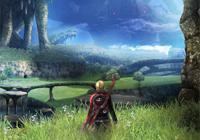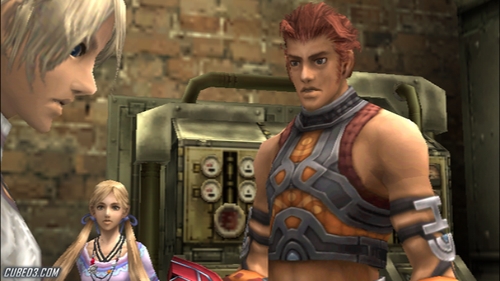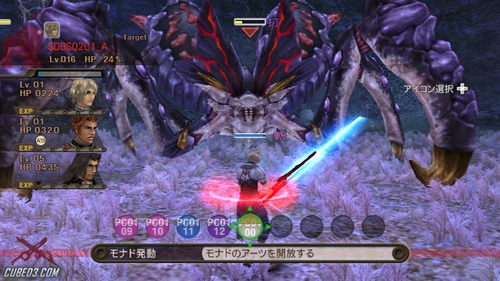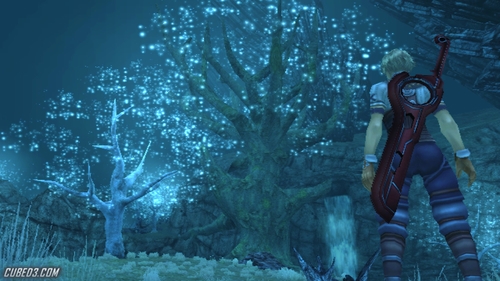Xenoblade Chronicles (Wii) Review
By Adam Riley  15.08.2011
15.08.2011

When Nintendo announced that it had purchased a controlling stake in Monolith Soft, taking 80% of Bandai Namco’s 96% share of the developer, there was a resounding silence as most gamers shrugged their shoulders at the prospect. After all, other than working on the Japanese-only Namco x Capcom and the Xenosaga trilogy (originally meant to be spread over six episodes, with two other games planned, fact fans), the company seemed relatively unknown. However, those more in the know realised the potential there was from such an acquisition, since founder Hirohide Sugiura-san and other staff members were formerly at Square Enix and had worked on classics such as the unforgettably sublime Xenogears. Also, how could anyone forget the special duo of Baten Kaitos: Eternal Wings and the Lost Ocean and Baten Kaitos Origins on the GameCube? After the very impressive Disaster: Day of Crisis, Monolith Soft is back on Wii with an RPG of a grand scale, Xenoblade Chronicles. Cubed3’s Adam Riley delves into what could well be not only the most epic adventure on Wii, but of this current generation.
Cubed3 definitely has a soft spot for Monolith Soft. From the two Baten Kaitos games on the GameCube, to Soma Bringer on DS, Disaster: Day of Crisis for Wii, and even the Bandai Namco-published releases such as Dragon Ball: Attack of the Saiyans, Xenosaga I & II, and Super Robot Taisen OG Saga: Endless Frontier. Therefore, when Xenoblade Chronicles arrived through the letterbox, it was swiftly slotted into the Wii console, turned on and adventuring was started with great aplomb. However, before tucking into what assuredly had to be a delightfully tasty voyage, both ears were filled with haunting piano music that swept emotions up, before building gently into more of a rousing crescendo of instruments that stimulated every nerve of the body. It has oft been said that a magnificent soundtrack can lift an average game most of the time, but in this case it was a superb tranquil melody that set the tone of the quest quite beautifully.
After letting the initial extract from the score wash over, delving into the options screen showed the attention to detail Monolith Soft has put into Xenoblade Chronicles. Both English and Japanese voice tracks are available, and there are plenty of smaller tweaks, such as being able to turn control and art descriptions, enemy icons and destination markers on or off as desired. There’s even the choice of camera zoom speed, its angle correction in relation to the ground, the general point of view, and adjusted movements when battling. Finally, and quite a nice little addition, some people who do not engross them in adventures can lose track of key information during event sequences due to distractions around them, so it there is the possibility to toggle speech/text between automatically scrolling when events take place or stopping after each sentence so players can catch up if distracted by manually pressing the action button.

In Xenoblade Chronicles (formerly known as Monado: Beginning of the World), two Titans were locked in battle for many years, before being stopped mid-fight one day. Eons later, the remains of a world called Bionis is under attack from a relentless force known as the Mechon, a strange set of soulless machines intent on wiping out the indigenous people, the Homs. The introductory scene opens up with a bloody battle taking place, and players taking control of a character named Dunban, a gung-ho fighter that wields a weapon called the Monado that, as his older companion, Dickson, points out is currently sapping away too much of his strength. As a third member, Mumkhar, attempts to slip away, players are quickly thrown into their first encounter with enemies and a mini-boss, plus a short tutorial explaining how pressing L or R on the Classic Controller / Classic Controller PRO will target a monster. Once targeted, a Battle Palette appears at the bottom of the screen, along with the current statistics of your team on the left side. The simplest selection is to pick with Fight icon, which then involves moving the lead character around using the analogue stick, adjusting the camera with the right analogue stick as required, in order to get close enough for Dunban to auto-attack, along with his comrades who do their own thing. As time progresses during battles, other icons may become available, such as the Art icon. These unleash special powers, two of which in the early stages are Monado Enchant for powering-up party members, and Monado Buster to deal major damage to an enemy. The range of Arts builds up over the adventure, with new ones being learned by the various characters that are taken control of, and their order on the Battle Palette can be tweaked in any way you wish.

After the opening interactive cinematic sequence (one of many throughout the heavily story-driven game), in which the sly Mumkhar scarpers and is left in an untenable situation, whilst Dickson lies helpless on the ground as Dunban goes roaring off to save the day, the camera starts to pull out from the scene, zooming further away, through the surroundings until it becomes apparent that this world being viewed is actually one of the Titans frozen in mid-battle in the middle of an ocean. The visual impact alone is breath-taking and goes to show how much Monolith Soft has become used to the Wii hardware after working on Disaster: Day of Crisis, a game that had its impressive moments, yet equally had its fair share of unusually poorly crafted elements. The visuals are not the only epic element as the feel is mirrored throughout all other aspects of Xenoblade to make it stand head and shoulders above nearly every other Wii release so far. The other aspect that hits home hard is exactly how engrossing Xenoblade Chronicles is, even from the first stages; something that pumps strongly through the veins of the game, with many hours being passed simply by aimlessly traversing the world, soaking up the sights.
One year after the grand scale battle it appears that the war has calmed slightly, with discarded shells of Mechon simply lying around as scrap, and a young boy named Shulk is attempting to scavenge what he can to make a shield. His friend, Reyn, jumps to his rescue when one creature comes alive, but it turns out to be a Krabble that was using the metal casing as protection. Cue battle scenario number two! Here Reyn knocks the Krabble over to expose its soft underbelly, and the player must use Shulk’s first offensive Art, Back Slash, to slice at it, as well as use Light Heal from time-to-time as required, all the while fighting to upbeat strings music playing in the background that aim to uplift spirits. Arts have what is known as a ‘cool down’ period so they cannot be over-used, and a short time must pass before they become available again. Eventually they can be levelled-up using Arts Points gained in battle, increasing their usefulness in various user-defined areas, such as reducing the cool down period or increasing their power. Another principal element is the Talent Art, which only fills up when an auto-attack connects with an enemy and offers a devastating special move, with each character having a unique attack. As mentioned earlier, the default array of the Arts in the Battle Palette at the bottom of the screen can be rearranged to make accessing favoured moves much simpler. Whilst enemies can be avoided when on your travels, it is not only worth fighting as often as possible due to the experience gained to level the team up, but rewards are given. As with classics such as Secret of Mana on SNES or more recent efforts like Solatorobo: Red the Hunter, a treasure chest will appear upon victory and players can choose what they wish to loot or merely take it all. The size of the chest is random, with bigger ones holding more items and weapons.

Although running away will eventually deter enemies giving chase, when trying to move on to the next area there are certain times when a green barrier will block your path, which means there are more enemies to clear before progression can be made. This is where tactics come into play when low on energy. For instance, striking from the correct side of a monster is imperative as ‘aggro’ can play a large part in the outcome of battles. This is the foe’s feelings of animosity towards a particular party member, with the level increasing more when one person focuses attacks on it, resulting in an ‘Aggro Ring’ appearing around said member. Placing your character in the right position can give the upper hand when dealing out damage. For example, Shulk’s Back Slash Art gives a Bonus Effect if used from behind, dishing out far more damage than if used from the side or front. To instigate this bonus, the timing and positioning in the battlefield are imperative, and using the aggro aspect can be advantageous as it means that if a monster’s attention is elsewhere due to its anger being focused on a different party member it is left vulnerable to a surprise attack, either from one player alone or a team chain-attack.

Whilst journeying and battling, there are many times when you can become disoriented, especially thanks to the fact that Xenoblade is filled with plenty of diversions. Along the way, eyes must be kept firmly open for collectibles, with them being added to the in-game ‘Collectopaedia’ and rewards dished out if rows of the archive are filled in. Building up a strong inventory of items and equipment is essential, with plenty of purchasing required en-route to obtain certain special forms of armour and weapons. The only drawback on the buy/sell side is that when a defensive or offensive item has been acquired, there is no ‘equip now’ option, meaning that players must remember to go back into their ‘Party’ menu, select the appropriate character and change everything around before getting back to the action, talking to the shop-keeper again and selling the unwanted wares. The positive here of this rather long-winded process, though, is probably that the characters reflect the changes in clothing and weaponry on-screen, as in Dragon Quest IX: Sentinels of the Starry Skies. However, the clunky nature of this process goes completely against the rest of the hassle-free feel of the rest of Xenoblade, with its ‘save almost anywhere’ approach; in other user friendly features, players’ positions are reset to the last visited landmark upon death, health is automatically recuperated after battles (slowly refilling between fights), warp functions allow jumping from area to area, and there is a day-to-night fast-forward option to trigger certain events.
To counter any disorientation, though, there is objective directional arrow that can be turned on or off, and keeping it on proves to be extremely useful, since it removes that age-old bugbear of having to wander aimlessly around, not quite knowing where the next trigger or key event is meant to be. Having the feature turned on makes Xenoblade Chronicles all the more enjoyable, with a small indicator at the top of the screen with a number beneath it revealing how many steps and in what direction you need to head before the next story advance point is. It is not the sort of hand-holding that makes a quest too simple, yet offers a welcomed small amount of extra guidance. Purists can turn it off, however, and rely on their memory, if necessary.

On the presentation side, as already touched upon, Xenoblade excels considerably, with nearly no loading times to be found, and the few that are in there last only a couple of seconds. Monolith Soft has tweaked the game perfectly so that the sprawling landscape can be navigated without the need for constant loading screens, á la Monster Hunter tri. In terms of voice acting, there is the obvious tendency to always prefer the Japanese voices to the Western ones, normally due to the language barrier and completely different set of intonations related to the accent meaning that a generic or bland voice is not quite as noticeable as when we hear some over-the-top US actor or, in the case of Xenoblade Chronicles, some extremely strong Cockney accent (a proper ”Cor blimey, guv’nor, I’m a Landanna” style). The voices used are pleasant enough and do grow on you over time, but in places they do not particularly seem to fit in with the imagined representation of the characters; plus, the emotion used, or lack thereof, is not always best suited to the scenario at hand. At least Nintendo has been good enough to give the decision over to the gamer as to whether English or Japanese voices are used whilst playing.
The key to Xenoblade Chronicles’ longevity, and what its system thrives on, is the fact that quests can be picked up and undertaken almost anywhere during the adventure, with a completion log to track everything, as well as the fact that its equipment element relies heavily on the Gem Slots. Quests, as in numerous other RPGs, come in all varieties, but all boil down to basically fulfilling the requests of others to collect things or defeat monsters. The Gem Slots work in a similar way to Materia in Final Fantasy VII or Espers in Final Fantasy VI, in that gems of differing type can be accrued, or eventually made, and inserted into a piece of equipment that has a free slot in order to boost the specific piece of armour or weapon in many distinct ways. It should be noted that not all equipment can be imbued with the power of gems due to some not having any slots. When buying items, certain equipment will have an ‘S’ to indicate slots for various gems to be placed, or a ‘U’ to show that there are already gems attached that cannot be removed, whilst having no letter means that it is simply of the regular variety. Leaving slots empty, and subsequently leading to an underpowered crew, can prove costly very quickly as the level of monsters lingering around the world can range from extremely weak to ridiculously tough even within the same region.

The depth and assortment of tasks that can be carried out in Xenoblade Chronicles is truly immense. When in villages and towns there is the chance to relate to certain locals, with an Affinity Chart tracking the named folk you have conversed with, which can result in unexpected reactions when returning to speak to one of these newfound ‘friends’ at a later stage, with other people from the Affinity Chart sometimes joining in to form group conversations. This is completely irrelevant to the completion of Xenoblade Chronicles, yet is another example of the extra care and attention poured into the project by Monolith Soft, allowing gamers to engage with other characters and track the changes in rapport, chatting to certain people about friends of theirs that you recently met, adding a pleasant sense of realism to proceedings. Affinity also comes into play when completing quests. Whilst meandering you will spot people with exclamation marks above their heads, indicating they have a request that needs completing, such as finding a missing engagement ring, collecting scales from enemies to forge a shield, or grabbing a special item to fix someone’s net. Numerous quests can be taken at any time, and upon finding the required item(s), the quest automatically closes and your affinity to that person increases. The same can happen when trading with inhabitants of the region, handing over items of greater value than the ones taken in return. The level of intricacy is astonishing.
There is level of encouragement to explore far and wide, with a whole host of hidden extras left lying around the world to be added to the player’s collection, and a bonus boost to the character’s experience and overall level for uncovering new, never before seen landmarks. Care must be taken when venturing into unknown territories, though, as monsters of a considerably higher level than Shulk will make a beeline for him, swatting him down like a fly with no hesitation. When enemies appear on the upper-right map/radar, tapping L or R can make Shulk target a creature from far off so that its name and status can be viewed from afar, and a wide berth can be taken if it looks out of your league. There will also be times when, upon rounding a corner, you are suddenly faced with an out of the ordinary beast that is not normally found simply skulking about in the general vicinity, and overcoming these will offer up unique bonuses, yet great care must be taken as they are normally no pushover.
While in the midst of battle, there is the chance to interact with your team members, giving them encouragement to help dispirited fighters, helping them if they are currently suffering from being dazed or toppled over, as well as improving the affinity between two party members. There is even an Elite Beat Agents element thrown in for the Battle Start Affinity and Burst Affinity features that build up team morale, with the player asked to tap the ‘b’ button of the Classic Controller PRO at just the right time (such as before an encounter commences). Once the affinity grows high enough, players can have ‘Heart-to-Heart’ situations when the members in question are part of the same party. As if that was not sufficient enough in terms of extras, there are a hefty amount of Achievements to be obtained, from discovering your first landmark, to developing a relationship with a set number of people, delivering 50 Critical Hits, and even performing specific moves. Monolith Soft has poured its heart and soul into Xenoblade Chronicles, creating not only a superlative effort on Wii, but an exemplar entry into the RPG genre in general.

Cubed3 Rating
Masterpiece - Platinum Award

Nintendo Wii owners have been waiting for something truly epic to grace the system since launch, and whilst there are superb experiences in the action and platform genres, RPGs have been rather thin on the ground. Good examples that have made it to Europe, such as Opoona, Final Fantasy Fables: Chocobo’s Dungeon, Fire Emblem: Radiant Dawn, Fragile Dreams, Final Fantasy Crystal Chronicles: The Crystal Bearers, and Sakura Wars: So Long My Love, have all been criminally overlooked. Now Monolith Soft’s grand Xenoblade Chronicles has arrived, bringing with it an sterling soundtrack, a phenomenal visual impact, vast amount of customisation, intriguing story and massive value for money. With it definitely proving itself to be of the highest calibre on Wii, it is time for RPG fans to take a stand and show their appreciation for this sublime classic.

Xenoblade
![]() 10/10
10/10
![]() 8/10
(10 Votes)
8/10
(10 Votes)
 Out now
Out now  Out now
Out now  Out now
Out now  Out now
Out now Comments
Comments are currently disabled

 Sign In
Sign In Game Details
Game Details Subscribe to this topic
Subscribe to this topic Features
Features





 Top
Top

